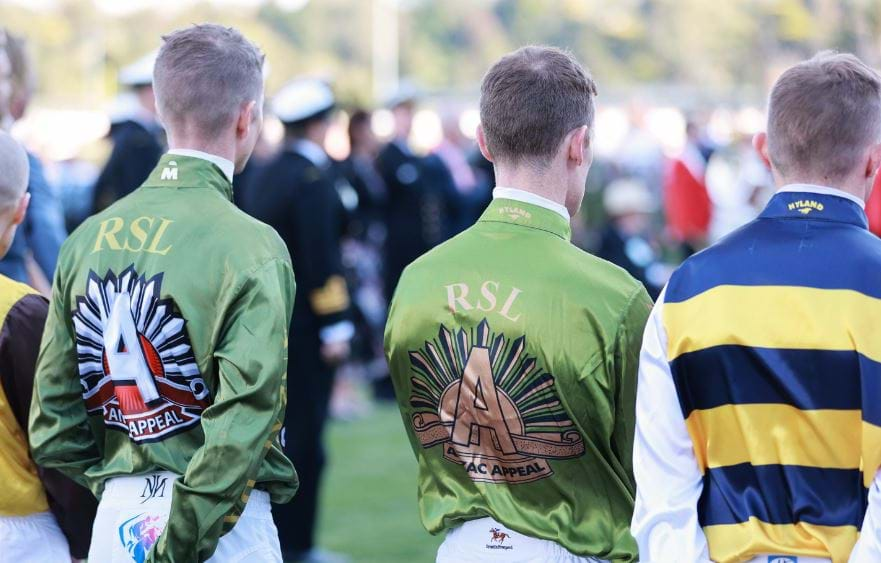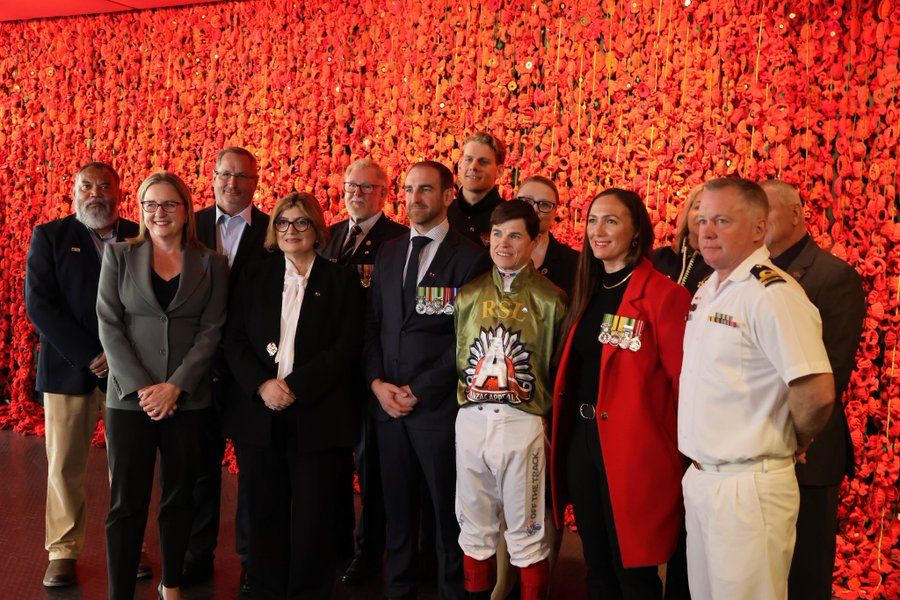Jockey Craig Williams joined Victoria’s Premier Jacinta Allan, Veterans, RSL Victoria representatives & sporting talent at the Shrine of Remembrance to unveil the upcoming #ANZACDay commemoration plans in Victoria.
Article – VRC
The ANZAC Day Race Day meeting has been a regular, though not quite continuous, part of Flemington’s long history.
ANZAC Day is our national day of remembrance commemorating Australians and New Zealanders who served, and those who died, in all wars, conflicts and peacekeeping operations. The date 25 April was the day of the first landing of ANZAC troops at Gallipoli in the First World War in 1915, one hundred and six years ago.
Racing played a part – and in the case of the VRC and the former Australian Jockey Club in Sydney, a huge part – in supporting patriotic fundraising in both the First and the Second World War.
Australia as a Federation has never quite been able to determine how best to mark ANZAC Day. Each State and Territory has its own laws. The idea of a national ANZAC Day holiday goes back to 1920, with the understanding that it would be “solemnly observed” – specifically meaning no horse racing. In 1925 Victoria passed its first ANZAC Day Observance Act, closing shops, theatres and hotels on 25 April and forbidding racing or sports gatherings.
This legislation stayed in force well beyond the Second World War. Other states slowly eased restrictions. Adelaide in 1937 inaugurated ANZAC Day races at Morphettville, raising funds for needy former servicemen and dependants. Sydney allowed afternoon football, but not racing until 1953.
New Victorian legislation in 1960 allowed the VRC to conduct races on ANZAC Day under strict conditions. A late starting time ensured no clashes with the traditional ANZAC Day march through the city. Any profits were to be directed to special ANZAC Day funds.
The VRC planned its first ANZAC Day races for 1960 – but torrential rain saw the meeting cancelled. This is why 1961 was Flemington’s first ANZAC Day race meeting. Race One was the Nurses’ Stakes, followed by the Army Handicap, Navy Handicap and Air Force Steeplechase. Jockey Jack Purtell won the feature Gallipoli Handicap, on Sporting Spirit. The meeting concluded with the Victory Highweight. This formula continued with minor variations for the next dozen years.

The VRC held its 1962 ANZAC Day meeting at Caulfield. Whenever ANZAC Day fell on a Sunday there was no meeting: this did not change until 1993. In 2001 and in 2007 the meeting went to Moonee Valley when Flemington’s track was under renovation. Otherwise, the VRC has conducted ANZAC Day races at Flemington continuously since 1961.
The program has evolved. In 1972 the venerable classic for three-year-olds, the VRC St Leger, switched from the Autumn Carnival to become the ANZAC Day feature. In its new spot it was won by such good horses as Taras Bulba, Lord Dudley, So Called and Gurner’s Lane.
Many individual heroes, battles and places of wartime significance have since been commemorated.
Race names have honoured, among others, British nurse Edith Cavell, General Sir John Monash, Lone Pine, the Somme, Villers-Brettoneux and Beersheba in the First World War; Nancy Wake, Kokoda, Shaggy Ridge, Changi and Hellfire Pass, the Normandy landings, the naval battles of Matapan and the Coral Sea, and the City of Darwin Squadron in the Second World War; Long Tan and Coral-Balmoral in Vietnam.
The Air Force Steeple became the William Newton Steeplechase in 1988, and the name continues with the Newton Handicap. Flight Lieutenant William Newton of 22 Squadron RAAF, an accomplished sportsman, was posthumously awarded the Victoria Cross for conspicuous bravery, repeatedly diving through intense anti-aircraft fire to bomb enemy positions on the north coast of New Guinea. When shot down on 18 March 1943, aged 23, he was captured and ceremonially beheaded. He was one of 20 Australians awarded the VC in the Second World War.
Much has been written of the role of the brave Australian war horses, including thoroughbreds and former racehorses. They are never forgotten at Flemington on ANZAC Day.
Eight VRC committeemen held office as Chairman across the 57 years from 1935: seven had been officers in either the First or Second World War – or in the case of Sir Chester Manifold, in both. The exception, Richard Turnbull, lost both of his sons on active service. Hilton Nicholas, Sir Rupert Steele and Peter Armytage all flew with the RAF, as did Armytage’s Vice Chairman, Ian Bayles who was awarded the Distinguished Flying Cross. General Sir Thomas Blamey was on the VRC Committee from 1947 until his death in 1951.
Behind the scenes at Flemington, and rarely told, are many other stories of war service. Racing continued at this racecourse during both the First and Second World Wars, but there were officials, staff, trainers, jockeys, stablehands and their families who enlisted and served.
One of the highlights of modern VRC ANZAC Day race meeting is an official commemoration centred on the Mounting Yard. To this, everyone brings their own memories. It’s racing’s way of saying, “Lest we forget”.
